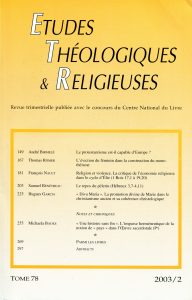La gestion du féminin dans les religions monothéistes constitue un problème qui a régulièrement été mis en évidence, depuis quelques décennies, par les lectures et les exégèses féministes. Lorsque le Dieu unique prend des attributs essentiellement (sinon exclusivement) mâles, il est difficile de ne pas y voir un phénomène de consolidation de la domination masculine au sein de la société. Dans cette étude, Thomas Römer retrace l’éviction progressive de la composante féminine dans la religion d’Israël. Après avoir souligné l’importance du culte des déesses tant dans la vénération populaire que dans le culte officiel, il montre de quelle manière l’émergence du monothéisme judéen à la fin de l’exil s’est accompagnée de la condamnation du culte des déesses. Certains aspects de ce culte se sont néanmoins maintenus, en particulier par la transposition d’images typiquement associées au féminin dans la représentation du Dieu unique. En ce sens, la Bible hébraïque témoigne déjà des limites d’une représentation exclusivement masculine de Dieu, et ouvre ainsi à une interrogation renouvelée sur notre manière de penser et de représenter ce Dieu qui, selon la Bible elle-même, transcende toutes les différences.
Since a few decades, feminist readings of the Bible have regularly emphasised the problem raised by the treatment of the female element in the monotheisms. When the only God is given essentially, if not exclusively, male attributes, it is difficult not to interpret this phenomenon as a way of consolidating the male domination over a given society. In this study, Thomas Römer traces the gradual eviction of the female component in the Israelite religion. After emphasising the importance of the cult of goddesses both in the popular religion and in the official cult, he demonstrates how the emergence of Judaean monotheism from the end of the exile was accompanied by a condemnation of the cult of goddesses. However, some aspects of this cult remained alive, in particular by the transfer of some characteristically « female » images over the representation of the only God. In this resepct, the Hebrew Bible already points to the limits of an exclusively male representation of God, thus opening to a renewed questioning about our ways of thinking and figuring this God who, according to the Bible itself, transcends all differences.
p. 167-180
Auteur
RÖMER Thomas
Thomas RÖMER est professeur d’Ancien Testament à la Faculté de théologie de l’Université de Lausanne.
